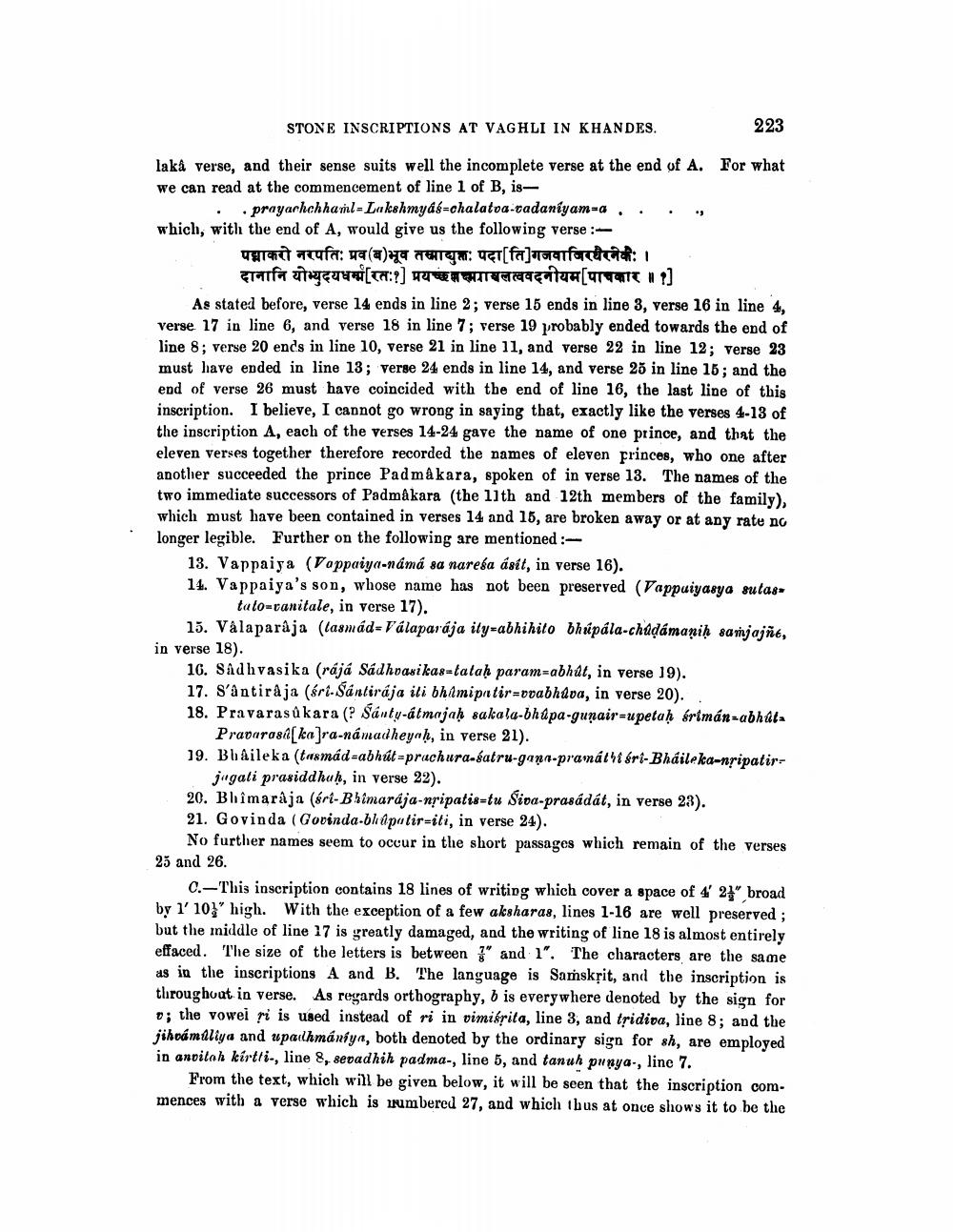________________
STONE INSCRIPTIONS AT VAGHLI IN KHANDES.
223
lakâ verse, and their sense suits well the incomplete verse at the end of A. For what we can read at the commencement of line 1 of B, is
· prayarkokkasil-Lukshmyáb-chalatea.vadaniyam-a which, with the end of A, would give us the following verse :
पद्माकरो नरपति: प्रव (ब) भूव तस्माद्युक्तः पदा[ति] गजवाजिरथैरनेकः । दानानि योभ्युदयधर्म्म[रतः १] प्रयच्छक्ष्मप्राचलत्ववदनीयम [पाचकार ॥ १]
As stated before, verse 14 ends in line 2; verse 15 ends in line 3, verse 16 in line 4, verse 17 in line 6, and verse 18 in line 7; verse 19 probably ended towards the end of line 8; verse 20 ends in line 10, verse 21 in line 11, and verse 22 in line 12; verse 23 must have ended in line 13; verse 24 ends in line 14, and verse 25 in line 15; and the end of verse 26 must have coincided with the end of line 16, the last line of this inscription. I believe, I cannot go wrong in saying that, exactly like the verses 4-13 of the inscription A, each of the verses 14-24 gave the name of one prince, and that the eleven verses together therefore recorded the names of eleven princes, who one after another succeeded the prince Padmakara, spoken of in verse 13. The names of the two immediate successors of Padmâkara (the 11th and 12th members of the family), which must have been contained in verses 14 and 15, are broken away or at any rate no longer legible. Further on the following are mentioned :—
13. Vappaiya (Foppaign-námá sa naresa dell, in verse 16).
14. Vappaiya's son, whose name has not been preserved (Vappuiyasya sutastato-vanitale, in verse 17).
15. Valaparaja (lasmád-Válaparája ily-abhikito dhápála-chidámanis sanjojāe, in verse 18).
16. Sadhvasika (rájá Sádhvasikas-tataḥ param=abhût, in verse 19).
17. S'antiraja (kel-Shatirája iti bhimipstir-vvabidea, in verse 20).
18. Pravarasikara (? Sauty-átmajas sakala-bkápa-gupair-upetas irimán-abhátPravoras[kara-ndwadkeyab, in verse 21).
19. Bileka (tamád-abbúl-pruchara-batra-gapa-pramáti irl-Bháileka-nripalir jagati prasiddhaḥ, in verse 22).
20. Bhimarija (rt-Bimardja-nripatis-tu Siva-prasddát, in verse 23).
21. Govinda (Govinda-bhupatir-iti, in verse 24).
No further names seem to occur in the short passages which remain of the verses 25 and 26.
C.-This inscription contains 18 lines of writing which cover a space of 4' 2" broad by 1' 10" high. With the exception of a few aksharas, lines 1-16 are well preserved; but the middle of line 17 is greatly damaged, and the writing of line 18 is almost entirely effaced. The size of the letters is between 3" and 1". The characters are the same as in the inscriptions A and B. The language is Samskrit, and the inscription is throughout in verse. As regards orthography, b is everywhere denoted by the sign for
; the vowel ri is used instead of ri in vimisrita, line 3, and tridiva, line 8; and the jihoamaliya and upadhmaniya, both denoted by the ordinary sign for sh, are employed in anvilah kirtti-, line 8, sevadhih padma-, line 5, and tanuh punya-, line 7.
From the text, which will be given below, it will be seen that the inscription commences with a verse which is numbered 27, and which thus at once shows it to be the




